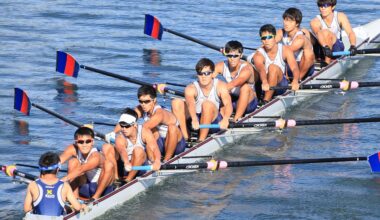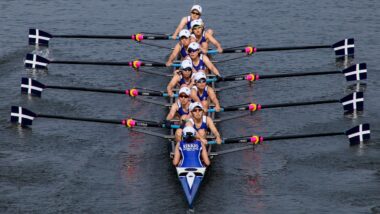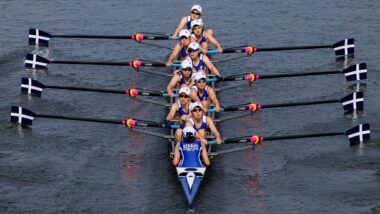Rowing Stroke Length: Definition and Importance
Understanding rowing stroke length is crucial for rowers seeking to improve their technique and efficiency on the water. Stroke length refers to the distance covered during a single complete rowing stroke, which includes both the drive and recovery phases. Typically measured in terms of distance traveled by the boat, stroke length can significantly impact overall boat speed and performance. It is a key element of effective rowing, enabling rowers to maximize their power output while minimizing energy expenditure. Optimizing stroke length requires a careful balance between reach and compression, enabling the rower to engage their core and legs without sacrificing form. Training on stroke length encourages rowers to focus on timing, rhythm, and coordination, which are essential for effective teamwork in crew boats. Factors such as boat design, water conditions, and individual physique must also be taken into consideration. The ideal stroke length can vary across different rowing disciplines, including sweep and sculling. Overall, mastering stroke length can lead to improved race times, enhanced endurance, and increased enjoyment of the sport.
Rowing stroke length is often a topic of discussion among coaches and athletes, as different rowers can exhibit vastly different stroke lengths based on personal style and comfort. Factors contributing to these differences include a rower’s height, arm length, and technique. Many experienced rowers develop a unique stroke pattern that best suits their physical attributes, while also adhering to overall team strategies. Coaches often use video analysis to assess stroke length and provide feedback. By evaluating, rowers can make necessary adjustments to enhance their performance. Increasing stroke length can help a rower capture more water, thereby producing more propulsion. However, a longer stroke can sometimes compromise a rower’s timing and balance; hence the critical need for training and practice. Athletes may experiment with varying their stroke length during training sessions to identify an optimal range. It is also vital to maintain a firm grip on the oar while allowing freedom of movement during the stroke. This balance between control and flexibility can make a considerable difference in achieving an efficient stroke length.
Measuring Stroke Length
To effectively measure rowing stroke length, rowers can employ various methods, including using GPS devices or specialized rowing technology like performance monitors. These tools can accurately track how far a rower travels during each stroke. Additionally, clubs often introduce calipers on rowing machines for measuring distance during indoor training, allowing rowers to simulate water conditions. By analyzing metrics like stroke rate, distance per stroke, and overall speed, rowers can assess the efficiency of their stroke length. Such data can also help in tracking performance progress over time, especially when gradually increasing the distance rowed. Coaches typically evaluate stroke length metrics to help athletes refine their technique. Regular assessments for stroke length can assist athletes in identifying patterns that emerge when transitioning from practice to competitive environments. Furthermore, establishing goals based on performance metrics can motivate rowers to enhance their capabilities systematically. Whether training for competitions or casual rowing, the insights gained from measuring stroke length can result in substantial advances in rowing proficiency.
Technique plays a vital role in determining the effectiveness of stroke length in rowing. A proper stroke involves effectively using larger muscle groups, especially the legs, back, and core. During the drive phase, emphasizing extending through the legs allows for a stronger push, contributing to a longer stroke. Following this, incorporating proper body mechanics, such as leaning forward and engaging the torso, engages additional muscle groups. This coordinated movement can create smoother transitions, ultimately leading to an efficient stroke. Rowers are encouraged to maintain a consistent tempo and avoid rushing through the recovery phase, which can negatively affect stroke length. During the recovery phase, the focus should be on relaxing the shoulders and maintaining a gentle rhythm as the oar comes back to the catch position. Additionally, maintaining an engaged grip on the oar allows for maximum control over the stroke. Continuous practice, along with targeted drills to improve synchronization, can go a long way in perfecting technique. Ultimately, mastering the technique associated with stroke length will empower rowers to optimize their performance significantly.
Competitive Context of Stroke Length
In a competitive rowing environment, the optimization of stroke length is paramount for achieving top performance levels. The intensity of races requires rowers to exert significant power in each stroke, linking every individual’s efforts towards a collective objective. While striving for longer strokes can yield advantages, maintaining cohesion within the team is equally essential. Team synchronization ultimately enhances power efficiency throughout the boat. Crew teams often spend hours working on their timing and rhythm, refining every element of their stroke to ensure maximum effect. Additionally, race strategies dictate specific stroke lengths that might differ depending on race conditions and competitor analysis. For instance, adjusting stroke length during a sprint finish versus a steady state can play a crucial role in maintaining speed. Rowers must also consider factors like wind, currents, and water conditions when evaluating the optimal stroke length voicing adjustments during races. The competitive landscape underscores that perfecting stroke length and associated techniques require a commitment to training, mental fortitude, and a collaborative approach.
Maintaining consistency in stroke length is fundamental for both training and competition settings. Continuous monitoring through practice allows rowers to develop muscle memory that leads to reliable performance under pressure. Achieving consistent stroke length can significantly positively influence overall timing, rhythm, and endurance. Moreover, partnering with a coach for drills focused on stroke length variation can keep training from becoming monotonous. Rowing ergometers present an opportunity for controlled adjustments, enabling rowers to simulate on-water conditions. Incorporating technique drills, such as pause drills or high-rate work, can effectively enhance stroke length awareness, allowing rowers to cycle through various lengths throughout their sessions. Additionally, regular feedback from coaches on performance metrics can keep rowers informed and accountable. They can also adapt their workouts to focus on areas that require specific attention. Remaining adaptable in both training and competition can lead to significant improvements in stroke length and, subsequently, in overall rowing performance. Ultimately, a dedication to refining stroke length encourages healthy competition among rowers.
Conclusion and Takeaways
In conclusion, mastering the intricacies of rowing stroke length is essential for any serious athlete looking to enhance their performance in the sport. Achieving an optimum stroke length requires dedicated practice, attention to technique, and thorough analysis of individual metrics. Factors such as personal physiology, environmental conditions, and boat dynamics all contribute to defining the ideal stroke length for each rower. Coaches and rowers alike must understand the importance of maintaining effective communication, emphasizing teamwork, and continuously evolving strategies based on performance feedback. The ongoing analysis of stroke length will empower athletes to elevate their rowing experience. Furthermore, rowing offers not only physical benefits but also mental rewards by fostering a sense of camaraderie among participants. Therefore, rowers should embrace the challenge of perfecting their stroke length, with the understanding that improvement within this element can lead to overall enjoyment and success in the sport.
With consistent practice and an understanding of stroke mechanics, rowers not only enhance their skills but also contribute to their team’s success. Engaging in regular assessments offers insights that shape individualized training programs geared towards improvement. By embedding the practices outlined in this article, rowers can navigate the complexities of stroke length in stride, adding to their overall effectiveness both on and off the water.





